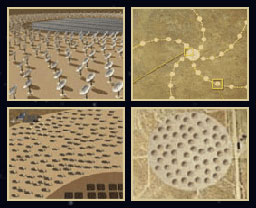NRAO Square Kilometer Array Program
NRAO Square Kilometre Array Program
 The NRAO is working with the international astronomical community to develop the scientific and technical concepts for the next generation of centimeter- and meter-wavelength telescopes after the Expanded Very Large Array (EVLA). These concepts comprise the Square Kilometre Array (SKA) Program, which ultimately may be realized by building several large international telescopes. Within the Observatory, an NRAO SKA Program Office has been formed as part of our participation in SKA. Its primary goals are to coordinate and plan NRAO participation in the various SKA activities, and to ensure a coherent Observatory approach by focusing NRAO development activities on the long-term goal of realizing the SKA.
The NRAO is working with the international astronomical community to develop the scientific and technical concepts for the next generation of centimeter- and meter-wavelength telescopes after the Expanded Very Large Array (EVLA). These concepts comprise the Square Kilometre Array (SKA) Program, which ultimately may be realized by building several large international telescopes. Within the Observatory, an NRAO SKA Program Office has been formed as part of our participation in SKA. Its primary goals are to coordinate and plan NRAO participation in the various SKA activities, and to ensure a coherent Observatory approach by focusing NRAO development activities on the long-term goal of realizing the SKA.
In the Astro2010 Decadal Survey, the NRAO participated with the US SKA Consortium in a program submission for construction of the mid-frequency portion of the SKA, which will cover a frequency range of ~ 0.5 GHz to 3-10 GHz. This will be primarily a survey instrument, exploring the evolution of galaxies, Dark Energy, transient sources, and the realm of strong gravity. Detailed testing of prototype low-cost dish antennas are expected to be carried out in the next few years in combination with the Expanded Very Large Array (EVLA).
NRAO is presently engaged in partnerships with several institutions, including the Radio Astronomy Laboratory of UC-Berkeley, for deployment of the Precision Array to Probe the Epoch of Reionization (PAPER), a possible precursor array to the lowest frequency SKA component. After initial testing at Green Bank, the first few PAPER antennas now have been deployed at the candidate SKA site in South Africa.
Finally, NRAO aims to participate in the construction of the high-frequency component of the SKA in the decade beginning in 2020. Covering a frequency range from 3 GHz or higher to ~ 25-50 GHz, this will be primarily a pointed instrument, following on from the discoveries of ALMA and EVLA to explore the formation of planets, stars, planets, and galaxies. NRAO led the Astro2010 submission for the North America Array, a possible realization of the highest frequency component of the SKA, based on the infrastructure of EVLA.





Connect with NRAO